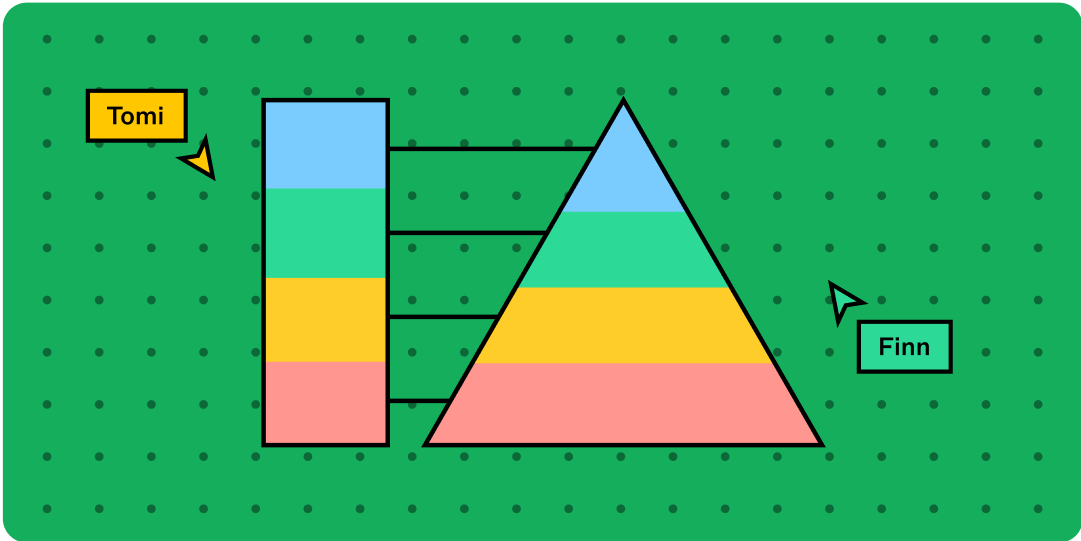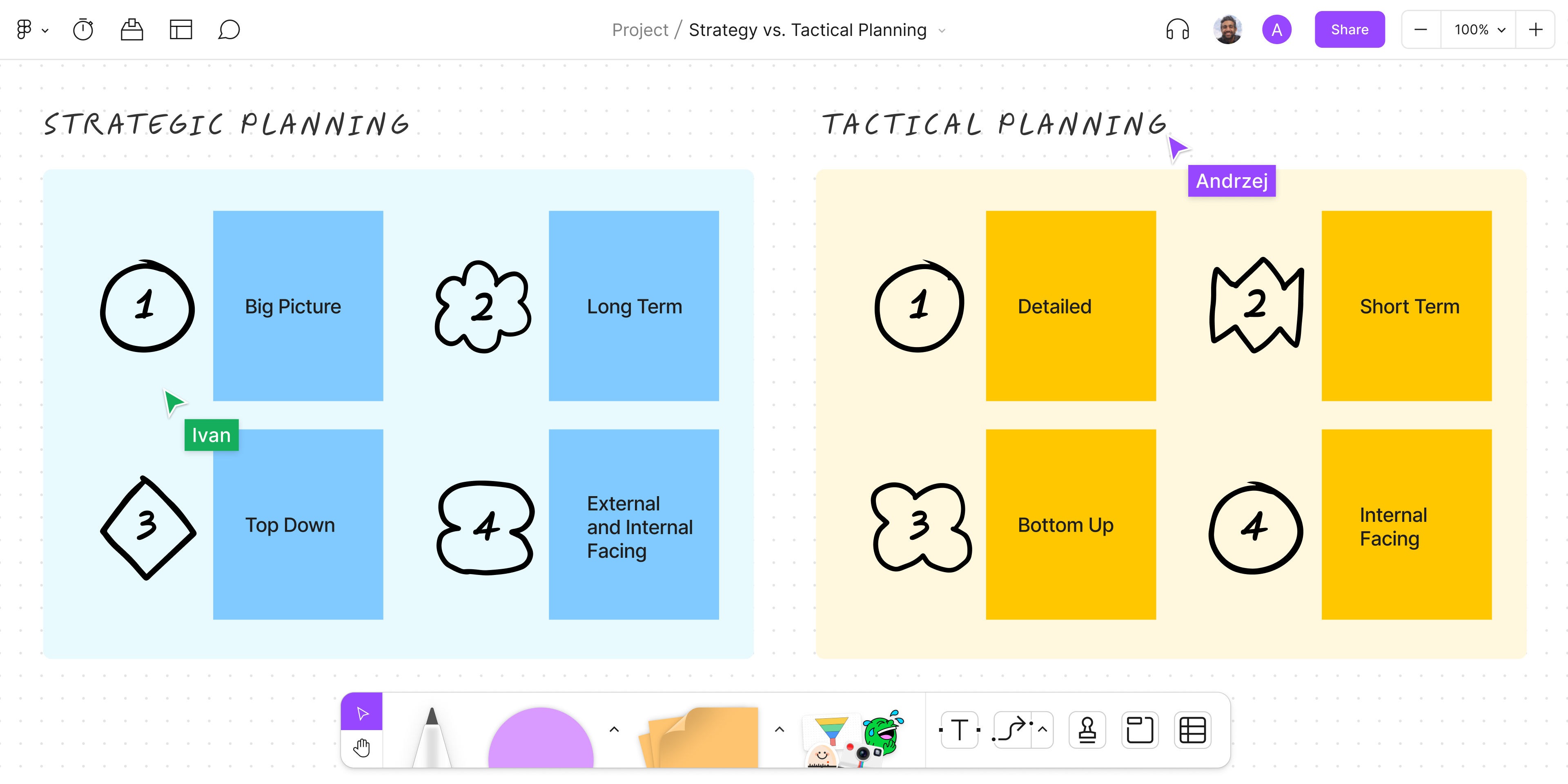Strategic vs. tactical planning

Whether you need to create a new product or service, build and execute a hiring plan, or take on a company rebrand, achieving your goals calls for some serious planning. That’s where strategic and tactical planning come in. While strategic planning involves big-picture thinking, tactical planning covers the nitty-gritty of turning strategy into action.
Read on to learn more about:
- What a strategic plan is and how you can benefit from one
- What a tactical plan is and key benefits of tactical planning
- The difference between tactical and strategic planning
What is a strategic plan?
Companies create a strategic plan to lock in long-term business objectives and goals. An effective strategic plan outlines the actions needed to reach specific goals. Once completed, it’s a useful tool to communicate a company’s overall direction to the wider organization.
A strategic plan answers such key questions as:
- What’s the state of your business, product, or service? What goes into running and turning a profit on your business in the current landscape?
- Where do you want your business, product, or service to go? Where do you see your business in three to five years?
- What does your organization have to do to achieve this? Which teams, what timelines, and what budgets are necessary?

Strategic planning doesn't have to be hard
FigJam's free strategic planning templates make it easy to get started. Get started today.
Benefits of successful strategic planning
Effective strategic planning is an ongoing process that:
- Gives clear direction, aligning all team members and key stakeholders around the same objectives and goals.
- Curbs subjective decision-making by using data and diverse points of view to inform and validate the strategic plan.
- Allows teams to gauge and improve performance, adjusting strategies to succeed in an ever-changing economy.
Strategic planning in 6 steps
Strategic planning typically spans six steps:
- Market assessment. Analyze top competitors, customer demand, supply-chain issues, and regulatory trends.
- SWOT analysis. Pinpoint your company’s strengths, weaknesses, opportunities, and threats in the marketplace. FigJam's SWOT analysis template helps you identify them.
- Mission and vision definition. Upper-level management and key stakeholders align the mission and vision with a SWOT analysis. Use FigJam’s template to define or redefine your mission and vision.
- High-level goal-setting. Leadership identifies overall business goals related to the mission and vision.
- Team-level objectives. Teams come up with objectives to hit the high-level goals.
- Resourcing. Hammer out overall requirements for financing, staffing, and other resources, such as technology investments.
What is a tactical plan?
A tactical plan is a roadmap that breaks down your long-term strategic plan into smaller, actionable steps — including daily, weekly, and monthly tasks and deadlines to help you meet key milestones. Tactical planning fills in the practical details of your day-to-day business operations, outlining who specifically is on the hook for each task or set of tasks.
Benefits of effective tactical planning
A thorough tactical plan can:
- Make it easier to achieve strategic goals by translating a lofty strategic plan into specific, easy-to-understand tasks.
- Boost employee engagement and performance by assigning clear roles and responsibilities.
- Keep teams on the right track, supporting the company’s mission and vision.
5 tactical planning basics
Tactical planning typically includes five key activities:
- Strategy validation. Map all the steps in a tactical plan to your strategic goal.
- Planning. Project managers work with team leaders to divvy up the plan into shorter phases. FigJam’s Gantt chart maker can help you plot out your plan.
- Assignments. Tap the right teams and team members for each task.
- Resource allocation. Assign budgeted strategic plan resources to teams and individuals to get the work done.
- KPI definition. Key stakeholders come up with KPIs (key performance indicators) to monitor progress against short-term objectives.
Differences between tactical and strategic planning at a glance
Strategic planning is:
- Big-picture. High level and conceptual by nature, strategic planning defines ways to deliver on the company mission and vision.
- Long-term. Companies set up three- to five-year strategic goals, sometimes extending plans to 10 years.
- Top down. Planning starts from the top. Upper management leads on strategy, pulling in key stakeholders along the way.
- External- and internal-facing. A good strategic plan relies on a solid understanding of both external market forces and internal operations.
Tactical planning is:
- Detailed. Tactical planning focuses on the specific day-to-day actions that drive business strategy.
- Short-term. A tactical plan includes short-term objectives and goals, covering a couple months to a year.
- Bottom up. Managers set tactical goals that teams execute on to support overall strategic goals.
- Internal-facing. Tactical planning is all about organizing internal teams so that they can meet deadlines and milestones.
Start planning your strategy and tactics with FigJam
Fire up your strategic and tactical brainstorm sessions using FigJam’s online collaborative whiteboard and ready-made templates. Then start building out your plans:
- To nail down strategy, FigJam’s strategic plan template helps you outline essentials. Then you can refine plans with FigJam’s library of strategic planning templates.
- To map tactics, use FigJam’s work plan, SMART goals, and KPI dashboard templates—and hit the ground running.
- To get everyone on board with your plans, check out these best practices on collaborating in FigJam.
Sources
[1] https://balancedscorecard.org/strategic-planning-basics/
[2] https://online.hbs.edu/blog/post/why-is-strategic-planning-important
[3] https://www.forbes.com/sites/georgedeeb/2018/12/04/the-top-6-steps-of-strategic-planning/
[4] https://predictableprofits.com/tactical-planning-what-when-and-why/
[5] https://www.indeed.com/career-advice/career-development/tactical-planning
[6] https://leaders.com/articles/executives/tactical-planning/#h-how-to-create-a-tactical-plan






